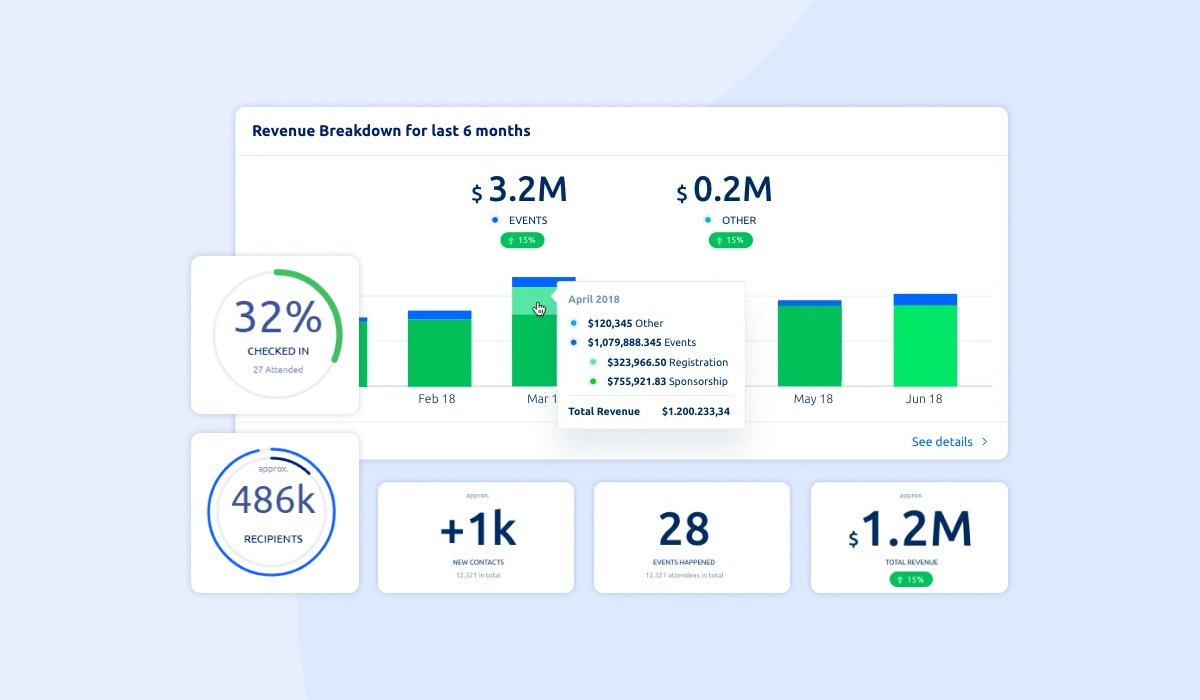![How to Plan Your Association Budget in 4 Easy Steps [with Practical Tips and Free Checklist] How to Plan Your Association Budget in 4 Easy Steps [with Practical Tips and Free Checklist]](/sites/default/files/2023-11/association%20budgeting%20header.webp)
Planning and managing an association's finances can pose challenges. As a board member or executive director, you carry immense responsibility for ensuring the organization's resources are allocated wisely, and developing an annual budget may seem overwhelming, especially if you lack financial expertise.
But budgeting doesn't have to be scary or complicated. With some preparation and organization, you can create a spending plan tailored to your association's goals and available funds.
In this guide, we'll walk you through the process in 4 easy steps, along with practical tips and a free template to help you plan your association's budget like a pro.
Key Takeaways:
- An association budget outlines projected income and expenses over a specific time period, usually annually. It serves as a spending plan and helps track cash flow.
- Budgeting provides many benefits for associations, including aligning spending with goals, avoiding deficits, and planning for the future.
- The budget planning process involves understanding your association's goals, estimating income, identifying expenses, and determining any surplus or deficit.
- Tips for effective association budgeting include starting early, involving key stakeholders, using historical data, and regularly reviewing the budget.
- A free association budget template is available to help you plan and track your numbers.
What is an Association Budget?

An association budget is a plan that outlines the projected income and expenses for your organization over a specific time period, usually for a fiscal year. The budget serves as a spending plan for your association and helps you align expenses with available revenue.
A well-developed budget includes both operating and capital expenses. Operating expenses are the regular day-to-day costs involved in running your association, like office supplies, software subscriptions, payroll, etc. Capital expenses are larger, less frequent expenses like equipment purchases and building improvements.
When creating a budget, it's important to include:
- Projected revenue from sources like membership dues, events, sponsorships, grants, donations, advertising, etc.
- Estimated expenses across all operating costs and program expenses.
- The resulting projected profit or loss is based on income minus expenses.
Starting with revenue and expense projections provides clear targets for your team, and tracking actual numbers throughout the year allows for necessary course corrections.
The association budget provides an estimate of cash inflows and outflows over the next year so you can plan accordingly. It also allows you to track actual spending compared to the budget to avoid deficits and keep your association financially healthy.
What are the Benefits of Budgeting for Professional Associations?
Aids in Forecasting
A thoughtful budget acts like a guide, predicting how your finances will help you achieve strategic goals based on projected spending and revenue. It identifies potential financial mistakes before they happen so you can avoid issues down the road.
This importance is reinforced by a recent McKinsey study, which found that over half of the executives surveyed were not satisfied with the transparency of their organization's budgeting process.
Effective Long-Term Planning
Budgeting enables effective long-term planning by allowing you to create 1, 3, and 5-year plans tailored to your association's objectives. Such forward-thinking prevents taking on projects that exceed your capabilities.
On a day-to-day basis, the budget provides oversight showing exactly where and how revenue is being spent. You can course-correct issues before they spiral out of control.
Drives Team Performance
The budget also drives team performance by setting clear monthly profit goals tied to incentives. When projections are compared to actual results, you can pinpoint areas needing improvement.
Helps Planning For Uncertainty
Associations that budget properly are prepared to handle unexpected setbacks without financial stress. The 2020 COVID-19 pandemic serves as a stark reminder of the importance of having a flexible budget that can adjust to unpredictable events.
The budget keeps your organization on track each month and headed in the right direction. Rather than being worried about finances, you'll have confidence in your spending strategy, knowing it's built to adapt and ensure your association's success.
How to Begin Planning an Association Budget?

The first step in developing your association's annual budget is to understand the overall budgeting process and what's involved.
Here is an overview of how to approach budget planning:
- Review financial statements: Gather data on income and expenses from the current and previous years to inform projections.
- Establish assumptions: Make reasonable assumptions about changes in revenue streams, costs, staffing levels, etc. for the coming year.
- Set organizational goals: Identify initiatives and projects to undertake in support of your association's objectives.
- Make initial departmental requests: Have program managers submit budget requests outlining their income needs and cost projections.
- Consolidate and prioritize requests: Combine requests from across the organization and prioritize based on available resources and alignment with goals.
- Present draft budget: Compile a draft budget for stakeholders to review and provide input.
- Finalize and approve: Make final adjustments and have the board formally approve the final budget.
- Communicate expectations: Share the approved budget and set expectations for sticking to the plan.
What's the Difference Between a Budget and a Cash Flow Statement?
While the budget and cash flow statement are related financial documents, they serve different purposes:
Budget | Cash Flow Statement | |
| Definition | A plan estimating income and expenses over a future period |
|
Time Frame | | Looks back at past actual activity |
Purpose | Provides a spending guide | |
Flexibility | Can be adjusted as needed | |
Specificity | Outlines broad categories | |
Represents | Expected financial activity |
|
So in summary, the budget helps you plan for the future while the cash flow statement records what already happened to analyze your financial situation.
Steps to Plan a Budget for Your Association
Planning a budget may seem daunting, but it can be broken down into four manageable steps:
Step 1: Understand Your Association's Goals
The first step is to get very clear on what your association wants to achieve in the coming year. This will inform how you allocate resources in the budget.
- Review your strategic plan and existing goals.
- Discuss any new initiatives planned for the next year.
- Prioritize goals and expected outcomes.
- Determine the financial implications of each goal.
With alignment between the budget and your goals, you can ensure funding for key objectives.
Step 2: Estimate Your Income for the Period Covered by the Budget
Next, realistically estimate all sources of income your association expects to receive based on past data, contracts, and economic conditions.
Remember, effective cash management is paramount; a U.S. Bank study indicated that 82% of business failures arise due to poor handling of finances. With this in mind, carefully assess the following income sources:
- Membership dues: It's essential to factor in membership retention rates. As a reference point, many associations typically experience an 85% retention rate.
- Events revenue: Reflect on your past events and gauge enrollments for future ones, adjusting for any anticipated changes or market shifts.
- Sponsorships: Delve into prior sponsorship cycles to gauge the potential revenue from both existing and prospective partnerships.
- Grants and donations: If your association regularly receives these, project future contributions based on past trends.
- Investment and interest income: Examine returns from previous investments and any interest earned from savings or other financial vehicles.
- Earned revenue: This encompasses areas such as advertising and merchandise sales.
In all your projections, a conservative approach is recommended. However, it's crucial to note that while associations have multiple revenue streams, many rely heavily on membership dues.

Leveraging robust association management software like Glue Up can significantly streamline your revenue estimation process across different streams. By centralizing and organizing data from past and ongoing financial activities, you can get a clear historical perspective that is instrumental in making informed projections.
Its CRM capabilities can help you effectively track membership retention rates and dues, offering a clear picture of this critical revenue source. Furthermore, you can integrate it with different accounting software like Quickbooks and Xero.
If you're looking to explore Glue Up's finance management features further, you can get a first-hand experience of all the capabilities here.
Step 3: Identify Your Expenses
Now estimate expenses across all areas of operations. This involves:
- Projecting operating costs like payroll, supplies, software, utilities, etc.
- Estimating one-time program and event costs.
- Planning for large capital expenditures like equipment purchases.
- Building in a contingency reserve for unplanned expenses.
Evaluate past spending and factor in any planned increases or reductions. Be thorough across all departments and cost centers.
Step 4: Determine Your Budget Surplus or Deficit

With estimates for both income and expenses, you can now calculate your projected surplus or deficit for the year.
Total all income amounts, then total all expenses.
If expenses are greater, that means you have a budget deficit. Alternatively, if your income exceeds expenses, you have a surplus. For deficits, determine where costs can be cut or additional revenue generated.
For deficits, look for areas to reduce spending like deferring projects or renegotiating contracts. Consider special assessments or dues increases to raise additional funds if needed. For surpluses, decide how to allocate extra funds based on your reserve study. Prioritize critical repair and replacement projects. Also, don’t forget to consider extra contributions to reserves or refunds to homeowners.
Monitoring your association's budget surplus or deficit each year helps ensure you operate sustainably long-term. Make adjustments to align income and expenses.
9 Tips for Planning an Effective Budget for Your Association
Follow these tips for developing an accurate, useful budget for your association:
- Don’t start with the budget. First, clarify your goals and establish clear objectives for what you want to accomplish. This provides direction for budget decisions.
- Create a current-year financial forecast. Take your actual year-to-date income and expenses and project them through year-end. This gives a starting point.
- Create a budget for the new year. With the previous year's forecast as a baseline, plan income and expenses for the new year.
- Summarize and present. Compile the budget projections into a consolidated document and slides to present to stakeholders for input.
- Use historical data and facts. Analyze past income and spending trends to inform realistic budget estimates.
- Involve key stakeholders. Get input from program managers, the finance committee, and the board early in the process.
- Budgets are living documents. Continuously monitor your actuals vs. budget and adjust as needed throughout the year.
- Use your outside accountant. Consult your CPA firm for economic projections and benchmarks from similar organizations.
- Keep a portion of your budget in reserve for unforeseen events.
Download Your Free Association Budget Planning Checklist
To help you get started planning your association's budget, you can download our free budget checklist here.
An association budget provides immense benefits when done right - giving you visibility into the future, encouraging responsible spending, and helping secure funding.
With a thoughtful budget in place and buy-in across your organization, you will be well prepared to allocate resources wisely. Your association will be able to undertake important initiatives in support of your mission and avoid potential deficits.
FAQs
How often should an association review and revise its budget?
It's recommended to review your actual expenses vs. budget at least quarterly and adjust the projections as needed to reflect changing conditions. A formal mid-year revision is common.
Should our association present a balanced budget or is a deficit acceptable?
It's best practice to budget for at least a slight surplus and avoid deficits, which can drain reserves. But occasionally a temporary and planned deficit may make sense for a special project.
Who should take the lead in managing the budgeting process?
While the board approves the final budget, the executive director or finance committee typically drives the budget development process and presents it for review.
How much detail does our budget document need to include?
The level of detail is up to your association, but cost centers and line items should be broken down enough for tracking and decision-making. High-level summaries are also useful.



